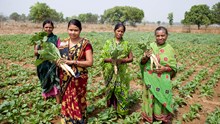
Along India's long and beautiful coastline, a silent revolution is underway. What was earlier merely a place for traditional fishing has now begun to transform into a goldmine for shrimp farming. Farmers, particularly in the coastal states, are beginning to see the advantages of this high-value aquaculture. The demand for shrimp, particularly in foreign markets, is tremendous. It is not surprising that regions such as Andhra Pradesh, Tamil Nadu, and West Bengal are experiencing an increasing demand for shrimp farming.
Though nearly 11.91 lakh hectares of brackish water land can be utilized for shrimp cultivation. Only about 1.2 lakh hectares are occupied at the moment for shrimp farming. That means more than 90% of the potential still lies unused, so farmers can step in.
Importance of Choosing the Right Location
Shrimp require a suitable environment to develop, similar to the need for crops to have a good environment of soil and water. Choosing the right site is extremely important. Ideally, the site should be only 1-3 meters above sea level, near the sea or a river, and not overly populated. Good access by road and electricity are also critical. A generator back-up is advisable since power is essential for the operation of pumps and water quality.
Another principal issue is security. Farms should be situated where there is no past record of theft or trouble. It’s also important that labor, equipment, and feed are easily available nearby.
Choosing the Right Shrimp
Selecting the appropriate species is the key to success. Two species are very much in demand in India—Tiger prawn (Penaeus monodon) and Indian white prawn (Penaeus indicus). They grow rapidly, command good prices, and are suitable for the Indian climate.
-
Penaeus monodon is also known as the tiger prawn. It grows rapidly and can attain gigantic sizes. A young prawn develops up to 100 grams within 5-6 months under favorable conditions. It has a high tolerance for salinity and temperature, which makes it simple to cultivate in various environments. It is popular among farmers due to its rapid growth and high market value.
-
Penaeus indicus is the Indian white prawn. It is another excellent choice. It will not be as big as the tiger prawn, but it still provides a good return. It has a thin shell, so there is more meat to eat, and it's easy to handle and harvest. Seeds are found everywhere in estuaries, and females can be matured in hatcheries with ease.
-
Another variety, Penaeus vannamei or white leg shrimp, has been gaining popularity in other Asian countries and grows rapidly. It survives in different salinity levels and requires a less protein-rich diet. It is, hence, low-cost to raise among the above-mentioned. It's a variety that's likely to become increasingly popular in the near term, though not yet cleared for open farming across India.

Water and Soil- Life of Shrimp Farming
Pure and pollution-free water is the backbone of shrimp farming. Shrimp prefer water between 26 and 32 degrees Celsius temperature and 10 to 25 ppt salinity. Water should have enough oxygen and low levels of harmful chemicals like ammonia and sulphide.
The quality of the soil is also equally crucial. The ideal soil is clay or loam with healthy pH levels. Sandy or acidic soils are to be avoided because they can cause erosion and stunted growth. Farmers should have their soil tested before constructing ponds to determine their texture and alkalinity. This act alone can prevent a lot of trouble in the future.
Stocking—Placing the Foundation Correctly
Shrimp farming starts with good seed. Good quality post-larvae (PL 15 to PL 20) shrimp should be selected from reputable hatcheries. Good seed is clear in color, active, and free from disease or parasites. Farmers can examine seed quality by inspecting hatcheries and seeing the shrimp during early morning or late evening.
Once a seed is chosen, it then needs to be adapted to the water of the pond. This means gradually adjusting it to the pond’s temperature and salinity over a few hours. If done properly, this step ensures the seed survives and grows well.
Stocking densities vary with the kind of system employed. For semi-intensive systems, 10 to 20 shrimp per square meter is usual. In more intensive systems, farmers stock up to 40 or even 50 per square meter, but only if they have the experience and resources to manage it.
Some farmers also use nursing systems. In this system, little portions of the ponds where the shrimp develop over a few weeks before being transferred to the general pond. This helps monitor their health and feeding closely during the critical early weeks.
A Step Towards Prosperity
Shrimp farming is more than a business. For many farmers, it has become a way to lift themselves out of poverty and build a better life for their families. Shrimp farming can be a very rewarding enterprise with proper planning, quality seed, and appropriate water and soil management.
As India continues to discover the riches of its coast, farmers have a golden chance to capitalize on the blue economy. It is time for more of our rural heroes to dive into this venture and bring prosperity to their coastal villages, one shrimp at a time.
















